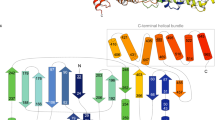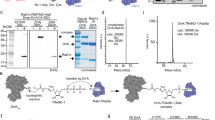Abstract
The intracellular pathogen Legionella pneumophila modulates the activity of host GTPases to direct the transport and assembly of the membrane-bound compartment in which it resides1,2,3,4,5,6. In vitro studies have indicated that the Legionella protein DrrA post-translationally modifies the GTPase Rab1 by a process called AMPylation7. Here we used mass spectrometry to investigate post-translational modifications to Rab1 that occur during infection of host cells by Legionella. Consistent with in vitro studies, DrrA-mediated AMPylation of a conserved tyrosine residue in the switch II region of Rab1 was detected during infection. In addition, a modification to an adjacent serine residue in Rab1 was discovered, which was independent of DrrA. The Legionella effector protein AnkX was required for this modification. Biochemical studies determined that AnkX directly mediates the covalent attachment of a phosphocholine moiety to Rab1. This phosphocholine transferase activity used CDP-choline as a substrate and required a conserved histidine residue located in the FIC domain of the AnkX protein. During infection, AnkX modified both Rab1 and Rab35, which explains how this protein modulates membrane transport through both the endocytic and exocytic pathways of the host cell. Thus, phosphocholination of Rab GTPases represents a mechanism by which bacterial FIC-domain-containing proteins can alter host-cell functions.
This is a preview of subscription content, access via your institution
Access options
Subscribe to this journal
Receive 51 print issues and online access
$199.00 per year
only $3.90 per issue
Buy this article
- Purchase on Springer Link
- Instant access to full article PDF
Prices may be subject to local taxes which are calculated during checkout




Similar content being viewed by others
References
Murata, T. et al. The Legionella pneumophila effector protein DrrA is a Rab1 guanine nucleotide-exchange factor. Nature Cell Biol. 8, 971–977 (2006)
Ingmundson, A., Delprato, A., Lambright, D. G. & Roy, C. R. Legionella pneumophila proteins that regulate Rab1 membrane cycling. Nature 450, 365–369 (2007)
Schoebel, S., Oesterlin, L. K., Blankenfeldt, W., Goody, R. S. & Itzen, A. RabGDI displacement by DrrA from Legionella is a consequence of its guanine nucleotide exchange activity. Mol. Cell 36, 1060–1072 (2009)
Machner, M. P. & Isberg, R. R. Targeting of host Rab GTPase function by the intravacuolar pathogen Legionella pneumophila . Dev. Cell 11, 47–56 (2006)
Machner, M. P. & Isberg, R. R. A bifunctional bacterial protein links GDI displacement to Rab1 activation. Science 318, 974–977 (2007)
Nagai, H., Kagan, J. C., Zhu, X., Kahn, R. A. & Roy, C. R. A bacterial guanine nucleotide exchange factor activates ARF on Legionella phagosomes. Science 295, 679–682 (2002)
Muller, M. P. et al. The Legionella effector protein DrrA AMPylates the membrane traffic regulator Rab1b. Science 329, 946–949 (2010)
Ninio, S. & Roy, C. R. Effector proteins translocated by Legionella pneumophila: strength in numbers. Trends Microbiol. 15, 372–380 (2007)
Yarbrough, M. L. & Orth, K. AMPylation is a new post-translational modiFICation. Nature Chem. Biol. 5, 378–379 (2009)
Yarbrough, M. L. et al. AMPylation of Rho GTPases by Vibrio VopS disrupts effector binding and downstream signaling. Science 323, 269–272 (2009)
Kinch, L. N., Yarbrough, M. L., Orth, K. & Grishin, N. V. Fido, a novel AMPylation domain common to Fic, Doc, and AvrB. PLoS ONE 4, e5818 (2009)
Roy, C. R. & Mukherjee, S. Bacterial FIC proteins AMP up infection. Sci. Signal. 2, pe14 (2009)
Worby, C. A. et al. The Fic domain: regulation of cell signaling by adenylylation. Mol. Cell 34, 93–103 (2009)
Pan, X., Luhrmann, A., Satoh, A., Laskowski-Arce, M. A. & Roy, C. R. Ankyrin repeat proteins comprise a diverse family of bacterial type IV effectors. Science 320, 1651–1654 (2008)
Brombacher, E. et al. Rab1 guanine nucleotide exchange factor SidM is a major phosphatidylinositol 4-phosphate-binding effector protein of Legionella pneumophila . J. Biol. Chem. 284, 4846–4856 (2009)
Zhu, Y. et al. Structural mechanism of host Rab1 activation by the bifunctional Legionella type IV effector SidM/DrrA. Proc. Natl Acad. Sci. USA 107, 4699–4704 (2010)
Suh, H. Y. et al. Structural insights into the dual nucleotide exchange and GDI displacement activity of SidM/DrrA. EMBO J. 29, 496–504 (2009)
Gross, M. L. Accurate masses for structure confirmation. J. Am. Soc. Mass Spectrom. 5, 57 (1994)
Li, Z. & Vance, D. E. Phosphatidylcholine and choline homeostasis. J. Lipid Res. 49, 1187–1194 (2008)
Chen, C. et al. Large-scale identification and translocation of type IV secretion substrates by Coxiella burnetii . Proc. Natl Acad. Sci. USA 107, 21755–21760 (2010)
Allaire, P. D. et al. The connecdenn DENN domain: a GEF for Rab35 mediating cargo-specific exit from early endosomes. Mol. Cell 37, 370–382 (2010)
Lovell, T. M. et al. Identification of a novel mammalian post-translational modification, phosphocholine, on placental secretory polypeptides. J. Mol. Endocrinol. 39, 189–198 (2007)
Grabitzki, J., Ahrend, M., Schachter, H., Geyer, R. & Lochnit, G. The PCome of Caenorhabditis elegans as a prototypic model system for parasitic nematodes: identification of phosphorylcholine-substituted proteins. Mol. Biochem. Parasitol. 161, 101–111 (2008)
Kagan, J. C., Stein, M. P., Pypaert, M. & Roy, C. R. Legionella subvert the functions of Rab1 and Sec22b to create a replicative organelle. J. Exp. Med. 199, 1201–1211 (2004)
Zuckman, D. M., Hung, J. B. & Roy, C. R. Pore-forming activity is not sufficient for Legionella pneumophila phagosome trafficking and intracellular growth. Mol. Microbiol. 32, 990–1001 (1999)
Berger, K. H., Merriam, J. J. & Isberg, R. R. Altered intracellular targeting properties associated with mutations in the Legionella pneumophila dotA gene. Mol. Microbiol. 14, 809–822 (1994)
Arasaki, K. & Roy, C. R. Legionella pneumophila promotes functional interactions between plasma membrane syntaxins and Sec22b. Traffic 11, 587–600 (2010)
Acknowledgements
We thank E. Gulcicek and K. Stone at the Yale Keck Proteomic Facility for advice and providing the high-resolution MS/MS analysis, K. Reinish and X. Wu for providing purified connecdenn, L. Lucast and P. De Camilli for assistance with lipid analysis, X. Pan for assistance in constructing AnkX plasmids, A. Hubber for technical assistance and H. Newton for editorial assistance. This work was supported by an Anna Fuller Fellowship (S.M.), National Institutes of Health (NIH) Grants F32 AI082927 (J.M.), and NIH grants R01-AI064559, R01-AI048770 and Northeast Biodefense Center Grant U54-AI057158-Lipkin (C.R.R.).
Author information
Authors and Affiliations
Contributions
S.M., X.L. and K.A. performed research. X.L. conducted the mass spectrometry analysis, K.A. generated HEK293 Fcγ 3×Flag–Rab1 stable cell line, J.M. conducted studies on the CBU_2078 protein, and S.M. conducted all other research. S.M., X.L., J.M. J.E.G. and C.R.R. analysed results and wrote manuscript.
Corresponding author
Ethics declarations
Competing interests
The authors declare no competing financial interests.
Supplementary information
Supplementary Figures
This file contains Supplementary Figures 1-9 with legends. (PDF 1612 kb)
Rights and permissions
About this article
Cite this article
Mukherjee, S., Liu, X., Arasaki, K. et al. Modulation of Rab GTPase function by a protein phosphocholine transferase. Nature 477, 103–106 (2011). https://doi.org/10.1038/nature10335
Received:
Accepted:
Published:
Issue Date:
DOI: https://doi.org/10.1038/nature10335
This article is cited by
-
Translocated Legionella pneumophila small RNAs mimic eukaryotic microRNAs targeting the host immune response
Nature Communications (2022)
-
A secreted effector with a dual role as a toxin and as a transcriptional factor
Nature Communications (2022)
-
Kinetic and structural parameters governing Fic-mediated adenylylation/AMPylation of the Hsp70 chaperone, BiP/GRP78
Cell Stress and Chaperones (2021)
-
Bacterial virulence mediated by orthogonal post-translational modification
Nature Chemical Biology (2020)
-
Characterization of the glucosyltransferase activity of Legionella pneumophila effector SetA
Naunyn-Schmiedeberg's Archives of Pharmacology (2019)
Comments
By submitting a comment you agree to abide by our Terms and Community Guidelines. If you find something abusive or that does not comply with our terms or guidelines please flag it as inappropriate.



